The Harn Museum: A Bright Sight for Sore Eyes

Though it was not in the best spirits that I approached the Harn Museum, I could feel upon my entrance a beauty which quickly filled me with awe and excitement. Indeed, the Harn has something to impress for everyone, with a variety of paintings, sculptures, glasswork, and a humble but lush garden of all types of greenery.
Students who have taken AP Art History may remember the golden litter of “Old Man’s Cloth”; a voluminous tapestry of discarded liquor bottle caps woven together with traditional African techniques. The glittering gold of the bottle caps shine back at you in fabric-like folds. It creates a subtle but important statement regarding the role Europeans had on Africa. The combination of the material and traditional techniques was created specifically to highlight the influence alcohol had as a form of currency during the slave trade (alcohol was given in exchange for people of rival tribes), and how African culture has changed due to the European influences it brought with it. It is breathtaking in both its size and luminosity, clear metaphors for the substantial effect alcohol had on millions of people. This is the first thing that catches the eye upon entering the contemporary art gallery, and the last thing you see upon leaving.
If only I could talk about all the other art in this museum. Rivera, O’Keefe, Chihuly, all wonderful pieces of art, but by far the most impressive, which must be addressed, would have to be Oat Field, by Claude Monet. The work instantly stands out. Short, pastel brushstrokes detail the piece, with the calming pale of the oats dusted with the various pinks and blues of wildflowers. The trees, off to the right of the painting, with one in the foreground, are darkened and cast shadows on the soft field, further contrasted by a pale sky. This is one of Monet’s lesser-known paintings, but for me it is just as eye catching as his Water Lilies. The ornate frame with its glowing brass works to bring the attention towards the light stillness of the painting, as if you yourself were looking out into the field.
The Museum, as an affiliate of the University of Florida, is in Gainesville, but it is still worth the trip for anyone interested. Not only does it contain Contemporary and European works such as previously discussed, but also a wide variety of culture and history that engulfs an exceptionally large majority of knowledge and art. It is a wonderful place to view the beautiful creations of the human mind.